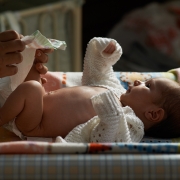
During the first month your baby will grow rapidly—about 5 to 7 ounces per week, or a pound of weight gain every 2-3 weeks. Normal newborn skin looks “leathery” or dry and will soon peel with very soft skin underneath, requiring no treatment. Newborns also have very fine hair covering their shoulders, back and other … Continue reading “First Month: Physical Appearance & Growth”

It is normal for mucus or secretions to accumulate in the eyes. This most likely is caused by plugged tear ducts, which can be gently cleansed with a clean cotton ball or washcloth with warm water. Notify your pediatrician if drainage from the eyes is excessive or if there is any redness or swelling of … Continue reading “Eyes”

Breastfed infants may normally have frequent, loose stools which can sometimes be confused with diarrhea. Diarrhea in children is watery and may occur 10-12 times a day. Treatment of diarrhea consists primarily of giving the baby adequate fluids while continuing the child’s regular diet. If your baby needs extra fluids, give Pedialyte, not water. Call … Continue reading “Diarrhea”

A diaper rash usually consists of redness or small bumps on the lower abdomen and diaper area that have direct contact with the soiled diaper. A rash of this type is rarely serious and usually clears in three or four days. For care: keep the skin clean and dry apply a diaper rash ointment or … Continue reading “Diaper Rash”

Your baby’s bedroom and crib should be extra safe. Choosing a crib that complies with appropriate safety standards will help keep your baby safe. Slats and rails should conform to standards for spacing and height, and mattresses should be very firm and fit snugly, leaving no space between the mattress and the walls of the … Continue reading “Cribs”

Your baby may develop a blue or purple color of the hands and feet, or on the lips and around the mouth. This occurs when your baby is cold or crying, and is more common in the first few days before she is feeding well. This is normal and should improve with calming or warming … Continue reading “Color Changes”

Crying gives your baby a way to call for help when hungry, cold, or uncomfortable. Fussy periods often increase in length and intensity during the first six weeks of life and then gradually decrease, usually disappearing by four months of age. When your baby cries, try to meet the most pressing needs first. If nothing … Continue reading “Colic & Shaken Baby Syndrome”

Unlike in children who are mobile and able to voluntarily put things in their mouths, true choking in newborns is rare. However, if a baby drinks very quickly he may cough and sputter a bit until he adjusts to feeding. It often proves helpful to sit him up and pat him on the back until … Continue reading “Choking”

The use of car seats appropriate for each child’s age and size helps to maximize automobile safety. Infants and toddlers should ride in a rear-facing seat until they are at least 2 years of age or reach the highest weight or height allowed by the manufacturer of their car seat. Read More: HealthyChildren.org HighwaySafety – … Continue reading “Car Seats”

Breastfeeding has many benefits, including providing easily-digested, complete nutrition and immune system benefits for baby. It has benefits for mothers as well. Breastfeeding is not easy at times and it may take a week or more to establish a good milk supply and consistent feedings. Make sure that feedings improve a little each day. Breastfeeding … Continue reading “Breastfeeding”